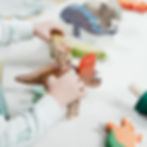
The holidays have come and gone and the novelty of your child's new toys has suddenly worn off. Toys and games that were favorites a month ago seem to be collecting dust. Try these tips to make them seem new again while also encouraging your child’s speech and language development!
1. Pretend it’s something else! Pretend play is SO important to speech, language, and cognitive development. It encourages imagination, social and emotional skills, flexible thinking, and more. During pretend play, children are required to describe their thoughts and ideas to their play partners. This encourages them to use new vocabulary, formulate novel sentences, and engage their listener to make sure he or she understands. Have a toy car? Pretend it’s a firetruck and put out a fire in the house or save a cat from a tree! Have some blocks? Instead of building a tower, pretend they’re food and feed all your friends! Have some pretend food? Pretend a banana is a phone and call a friend or turn an apple into a ball and roll it down a ramp!
2. Take turns! Turn taking is essential for all communicative exchanges. It helps engage children with you and each other and prepares them for conversational speech when they get older. Try adding turn taking to an activity that you normally don’t, such as a puzzle or playing with dolls. Instead of letting your child complete the puzzle by him or herself, join in and take turns putting the pieces in or take turns feeding the baby.
3. Move it outside! Make any toy more exciting by playing with it in a new environment. Especially given the situation we are all currently in, kids may be spending a lot of time indoors. Bringing familiar toys outside can help make them seem new again. Have some magnet letters? Try hiding them in the sand box for your child to find. Play hide and seek with your child’s favorite stuffed animal and work on describing location phrases or telling stories about how Mr. Bear ended up under the slide! When the weather’s nice, take out the hose and start a car wash with your child’s toy cars!
4. Organize toys in a new way! Combining toys in a new way can help spark ideas for new ways to play with them. If you typically organize toys by category (e.g. cars, blocks, kitchen, etc.), try grouping them by color, size, or shape. Put all the red toys in one bin and all the green toys in another. Seeing Elmo with a barn might encourage your child to play with these two toys together, even if he or she never has before. When you are ready to clean up, organize the toys in a different way and include your child in the process. This not only helps them learn to clean up when they’re done, but also works on sorting and categorization skills!
5. Add music! So many children love music and many children’s songs tell a story. Acting out the song or adding visuals while singing songs can make them even more meaningful. Take out a toy bus and put in the driver, mama, and baby as you sing Wheels on the Bus. Use a farm while you sing Old MacDonald and have your child practice making the animal sounds.
Pro Tip: Many pre-recorded songs and videos sing VERY quickly, which can be frustrating for young children trying to sing along, especially if he or she is just learning to talk or has difficulty with communication. While you’re listening to the song, pause it periodically to give your child a chance to sing some of the words him or herself and act it out with your toys. Even better, sing it yourself! When singing songs yourself, you not only can engage more fully with your child by going at his or her pace, but you can also change the lyrics to make them more meaningful. Is your child more interested in zoo animals than farm animals? Sing Old MacDonald had a zoo!
